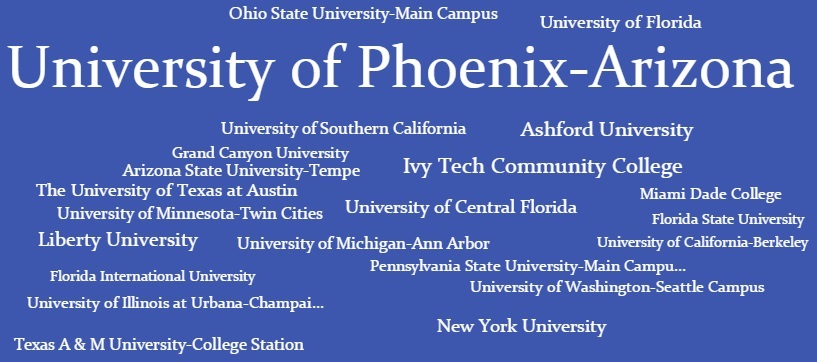- Home
- /
- SAS Communities Library
- /
- Chart a Week Series: Higher Education in the United States
- RSS Feed
- Mark as New
- Mark as Read
- Bookmark
- Subscribe
- Printer Friendly Page
- Report Inappropriate Content
Chart a Week Series: Higher Education in the United States
- Article History
- RSS Feed
- Mark as New
- Mark as Read
- Bookmark
- Subscribe
- Printer Friendly Page
- Report Inappropriate Content
As the attainment of a college degree becomes more of a necessity rather than an option, the choice of selecting a major, degree program, and university are highly stressed in today’s world. Therefore, we analyzed higher education data provided by DATAUSA in SAS Visual Analytics 7.3 to display common themes among majors offered and the most degree-awarding universities.
The United States (U.S.) Department of Education collects a large supply of data regarding higher education, including the most common majors to pursue a bachelor’s degree in, and all U.S. institutions ranked by the total number of graduates in 2014.
As shown by the tree map, the number of students who were awarded bachelor’s degrees are predominantly in the following degree programs: business, health, and social sciences.
By drilling down into this graph, the majors with the most degrees awarded are general business administration and management (140,003), general psychology (116,070), and registered nursing (114,010).
However, according to a study conducted by Georgetown University, the top three highest paying college majors are petroleum engineering, pharmaceutical sciences and administration, and metallurgical engineering. Therefore, there is no correlation among majors with the most number of degrees awarded and future pay.
Further, the data provided allowed us to evaluate all public and private institutions within the U.S. ranked by total number of graduates, with the University of Phoenix-Arizona being the top university to graduate 59,390 students.
From the word cloud, we derived the top five institutions in the U.S., by degrees granted, broken out by gender. For each institution displayed on the bar chart, it is evident that more female students attained degrees than their male counterparts in 2014. Leading us to question the student gender distribution of such universities, in which all five are known for being significantly female dominant schools. Would you have known there to be an association between the percentage of female graduates and highest degree awarding universities?
Aside from university data, what types of visualizations would be of interest in the weeks to come? Let us know what you think in the comments below.
Data Sources: http://datausa.io/profile/geo/united-states/#education
Don't miss out on SAS Innovate - Register now for the FREE Livestream!
Can't make it to Vegas? No problem! Watch our general sessions LIVE or on-demand starting April 17th. Hear from SAS execs, best-selling author Adam Grant, Hot Ones host Sean Evans, top tech journalist Kara Swisher, AI expert Cassie Kozyrkov, and the mind-blowing dance crew iLuminate! Plus, get access to over 20 breakout sessions.
Free course: Data Literacy Essentials
Data Literacy is for all, even absolute beginners. Jump on board with this free e-learning and boost your career prospects.
Get Started
- Find more articles tagged with:
- chart_a_week_series




